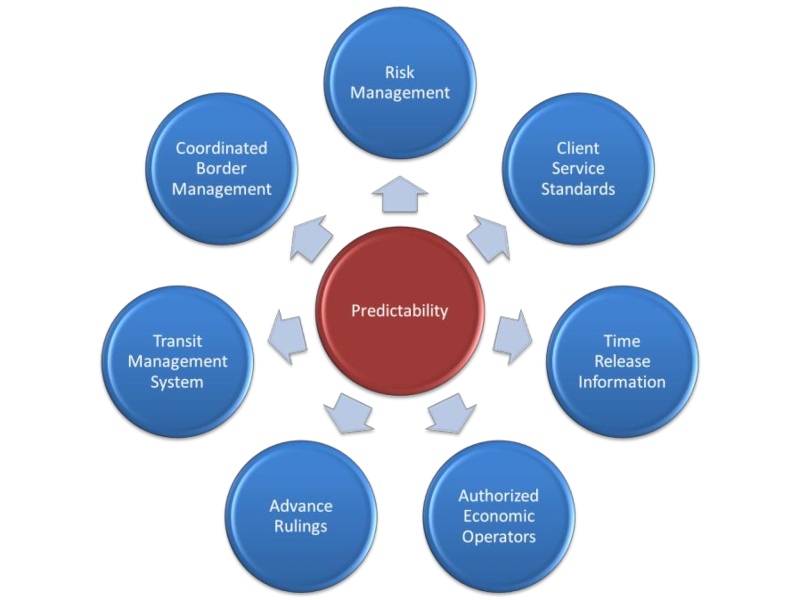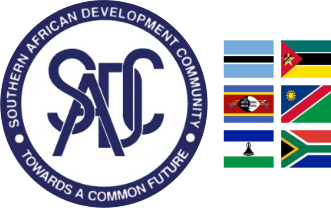The purpose of the predictability activity cluster is to ensure that trade laws, regulations, administrative guidelines, and procedures are applied in a stable and uniform manner to encourage investment, spark job creation, and ensure that consumers are able to enjoy the benefits of competitive markets (e.g., new choices and lower prices). The figure below summarises activity areas.

Risk Management
Article 7, Paragraph 4, of the WTO TFA requires that each Member, to the extent possible, adopt or maintain a risk management system for customs control and apply risk management so as to avoid arbitrary or unjustifiable discrimination, or disguised restrictions on international trade. It requires that each Member concentrate customs control and, to the extent possible, other border controls on high-risk consignments and expedite the release of low-risk consignments. The term “risk management,” as used in the title of Paragraph 4 tends to be equated with automated risk-based targeting systems. Most customs authorities have implemented basic selectivity processes to target high-risk transactions, often as a byproduct of automation.
As outlined in Activity 5.2.5, SADC Member States should survey trade facilitation procedures covered by international standards, including risk management administration. The survey should reveal which, if any, Member States have a comprehensive risk management system. Such systems apply risk-based analytical processes to identify key industries, ascertain compliance levels, and establish measurable compliance goals complemented by public-private plans to meet those goals. This approach encompasses other potential threats to national interests and public safety, such as agricultural pests and diseases that could have a devastating economic impact or toxic substances that could have a detrimental environmental impact.
This expanded concept of risk management is important when promoting trade facilitation among other government agencies. As stated in the World Bank’s Border Management Modernization Handbook:
"Little is achieved when a Customs agency adds automation, or when it adopts risk management principles allowing the selective examination of imports, so long as other agencies are not automated and continue to routinely inspect goods regardless of the level of risk involved."
Client Service Standards
SADC should conduct a comprehensive survey in Member States to consider and explore existing best practices for client service standards in the region and consider piloting a client service charter to expedite cargo release. Customs, trade-related agencies, and the trading community should collaborate to define and document normal service standards or expectations for each major cargo release function in a charter. The charter includes management reporting requirements to monitor the performance of customs and trade-related agencies in meeting standards.
Once refined, the pilot standards could be introduced in all Member States with the ultimate goal being development of regional model for service standards.
Time Release Information
WTO Members are encouraged to measure and publish the average amount of time it takes for them to release goods. The WCO’s Time Release Study (TRS) Guide Version 2 provides a systematic method for measuring the average time it takes to release cargo and at each step or intervention in a border procedure. As Members of the WCO, SADC Member States can ask for assistance in completing a TRS.
A TRS measures how effectively customs and other regulatory and private sector participants process imports, exports, and in-transit movements. It seeks to measure trade flows elements with great accuracy so performance improvements are properly conceived and implemented.
Trade Facilitation Measures for Authorised Economic Operators
Article 7, Paragraph 7, of the WTO TFA requires WTO Members to institute additional facilitation measures for qualifying trade operators. An authorized economic operator (AEO) is a trader who has volunteered to share compliance responsibility and ensure supply chain security.
The WCO originally promoted AEO programmes as a customs initiative. In June 2012 it added to the SAFE Framework a chapter on coordinated border management to ensure sufficient attention to other agencies’ interests in “trusted trader” programmes. All agencies that engage in international cargo inspection must be included so their distinct requirements do not limit the benefits of such programmes. This need to balance compliance and facilitation requirements - requirements that are compatible though often viewed as competing—is also reflected in the WTO TFA.
Post-clearance auditing compliments any AEO programme. Article 7, Paragraph 5 of the WTO TFA requires that in order to expedite the release of goods, each member shall adopt or maintain post-clearance audit to ensure compliance with Customs and other related laws and regulations. Post-clearance auditing is one of the most effective trade facilitation strategies available to border agencies because it enables the immediate release of imported cargo through the subsequent use of audit-based regulatory controls. When implemented as part of an overall regulatory compliance framework, post-clearance audit can deliver improved rates of compliance and facilitate cross-border transactions without any loss of border control.
Post-clearance auditing can help identify those high-risk traders whose future transactions may require intensive scrutiny. It can also serve to identify low-risk traders eligible for any ‘fast-track’ permissions and simplified procedures offered to traders under an AEO programme and any other compliance recognition-based programmes that benefit both the government and business sectors in terms of time and cost savings.
Advance Rulings
Advance rulings facilitate trade, promote transparency and consistency in customs operations, and foster the participation of small and medium-sized enterprises in global commerce. Well-implemented advance ruling systems provide certainty to traders and their agents about how their goods will be treated at the time of import, promote consistent application of customs rulings and law, foster trust between customs and traders, and provide a transparent framework that encourages compliance.
Article 3 of the WTO TFA defines an advance ruling as a written decision provided by a Member to an applicant prior to the importation of a good covered by the application that sets forth the treatment that the Member shall provide to the good at the time of importation with regard to: i, the good’s tariff classification, and ii, the origin of the goods.
The TFA encourages Members to provide advance rulings on the appropriate method or criteria, and the application thereof, to be used for determining the customs value under a particular set of facts; the applicability of the Member’s requirements for relief or exemption from customs duties; the application of the Member’s requirements for quotas, including tariff quotas; and any additional matters for which a Member considers it appropriate to issue an advance ruling.
Since the advance ruling process is rooted in customs knowledge and expertise, an effective process can be implemented readily at the Member State level. Still, SADC [Structures and Secretariat] can develop a regional scheme with common procedures, service standards, mutual recognition and acceptance, and an internet-based database. To assist this development, draft legal text covering advance rulings for possible amendment of the SADC Model Customs Act is provided in Annex 3.
Regional Transit Management System
The SADC Transit Management System was adopted in 2009 to harmonize and standardize procedures for goods in transit. It includes transit procedures and a bond guarantee system. In response to challenges with implementation and developments in technology, the Subcommittee on Customs Cooperation is reviewing the procedures and the Regional Customs Transit Bond Guarantee (RCTBG).
The Customs Audit Report of 2011 confirmed that Member States were not using the Transit Management System. The review of the bond guarantee mechanism has entailed gathering input from the insurance and banking sector on development of a guarantee system for use across the region. SADC is also collaborating with the COMESA Secretariat in developing information and communication technology aspects of the system.
SADC needs to continue to consider existing instruments for transit control in other RECs (e.g. COMESA and EAC) and revise its review of the Transit Management System to ensure the WTO TFA guidelines and mandates covered in Article 11 are included and the system is adjusted as needed.
Border Management Issues
Studies have been conducted in the Southern Africa region by institutions such as the World Bank, which established that the high cost of exporting and importing goods to, from, and within the Southern Africa region discourages international and intra-regional trade, makes commerce and industry less competitive, and contributes to food insecurity. The port and border post delays have been identified as contributing significantly to the high cost of transportation in the region. A 2010 World Bank Report on Africa’s infrastructure estimated that the cost of delays for an eight axle interlink truck transiting from Lusaka, Zambia to Durban, South Africa to be about $300 a day and that it takes an average of eight days to do a journey of 2500 kilometers; out of the eight days, four days are spent at border crossings.
To improve management efficiency at the borders and improve trade facilitation in the region, SADC is promoting the implementation of trade facilitation tools such as Coordinated Border Management (CBM), One Stop Border Post (OSBP) and National Single Window (NSW) at both national and regional levels. SADC is prioritizing the implementation of the CBM Programme which should bring almost immediate results and will lay a good foundation for these other initiatives by ensuring there is coordination among border stakeholders for effective and efficient border clearance procedures.
The CBM Programme is implemented in a number of stages including, carrying out a Border Operations Assessment to identify key challenges and to make recommendations at a particular border, conducting national and border workshops to validate results, forming Joint Border Committees (JBC), drawing JBC Action Plans and implementing the plans to improve border management and efficiency.
In November 2012, SADC introduced a “Guidelines on Coordinated Border Management” document to provide Member States with a comprehensive methodology in implementing CBM. The guidelines were designed using the EU Integrated Border Management (IBM) concept. It should be noted from the definition that the main focus of IBM was management rather than operations or processes. Operations or processes at the border are managed by different agencies.
The concern of IBM was that the “management” by the agencies – i.e. their policies and strategies – be “coordinated.” This will lead to integration of actions, activities, and processes where appropriate. It should also be noted that IBM concerns all the agencies at the border equally as each has its own statutory mandate and national interests to protect. These guidelines were therefore for all agencies represented at the border. There were six key management areas identified within the guidelines’ structure, which included:
- Legal and regulatory framework;
- Institutional framework;
- Standard Operating Procedures for Cooperation;
- Human Resource training;
- Communications and Information exchange; and
- Infrastructure and equipment to support cooperation and coordination.
The implementation of CBM is therefore an important factor not only for the regional integration agenda but also for the success of various donor-funded regional projects for cross-border facilitation. It is for this reason that the MTF approved these guidelines for use by Member States wishing to improve management of their borders and cross-border cooperation.


